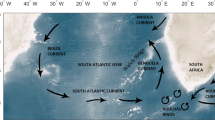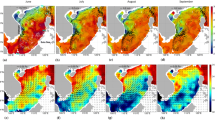Abstract
In this study, a separation index for the East Korea Warm Current (EKWC) is defined by Lagrangian particle tracking using surface geostrophic currents based on satellite-observed absolute dynamic topography. After determining the main stream from the inflow through the western channel of the Korea Strait, the separation index is obtained by averaging the latitude of the main particle trajectories crossing the meridian along 130.5°E. Although the separation index is obtained from coastal velocity, it describes well the surface circulation patterns in the Ulleung Basin. When it is low (i.e., the EKWC separates at low latitude), the flow toward the Japanese coast is the strongest and the EKWC is weak. In the middle phase of the separation index, a large portion of the EKWC meanders and forms the Ulleung Warm Eddy-like feature. When the separation index is high, the EKWC stretches further northward to almost 40°N. Therefore, the separation index could be used as a simple representation of the surface circulation pattern in the East/Japan Sea.
Similar content being viewed by others
References
Chang K-I, Hogg NG, Suk M-S, Byun S-K, Kim Y-G, Kim K (2002) Mean flow and variability in the southwestern East Sea. Deep-Sea Res Pt I 49:2261–2279
Chang K-I, Teague WJ, Lyu SJ, Perkins HT, Lee DK, Watts DR, Kim YB, Mitchell DA, Lee CM, Kim K (2004) Circulation and currents in the southwestern East/Japan Sea: overview and review. Prog Oceanogr 61:105–156
Cho Y-K, Kim K (1996) Seasonal variation of the East Korea Warm Current and its relation with the cold water. La Mer 34:172–182
Cho Y-K, Kim K (2000) Branching mechanism of the Tsushima Current in the Korea Strait. J Phys Oceanogr 30:2788–2797
Choi B-J, Haidvogel DB, Cho YK (2004) Nonseasonal sea level variations in the Japan/East Sea from satellite altimeter data. J Geophys Res-Oceans 109:C12028. doi:10.1029/2004JC002387
Choi B-J, Byun D-S, Lee K-H (2012) Satellite-altimeter-derived East Sea surface currents: estimation, description and variability pattern. J Korean Soc Oceanogr 17:225–242
Choi B-J, Cho SH, Jung HS, Lee S-H, Byun D-S, Kwon K (2018) Interannual variation of surface circulation in the Japan/East Sea due to external forcings and intrinsic variability. Ocean Sci J 53:1–16
Dee DP, Uppala SM, Simmons AJ, Berrisford P, Poli P, Kobayashi S, Andrae U, Balmaseda MA, Balsamo G, Bauer P, Bechtold P, Beljaars ACM, van de Berg L, Bidlot J, Bormann N, Delsol C, Dragani R, Fuentes M, Geer AJ, Haimberger L, Healy SB, Hersbach H, Hólm EV, Isaksen L, Kållberg P, Köhler M, Matricardi M, McNally AP, Monge-Sanz BM, Morcrette J-J, Park B-K, Peubey C, de Rosnay P, Tavolato C, Thépaut J-N, Vitart F (2011) The ERA-Interim reanalysis: configuration and performance of the data assimilation system. Q J Roy Meteor Soc 137:553–597
Frankignoul C, Sennéchael N, Kwon Y-O, Alexander MA (2011) Influence of the meridional shifts of the Kuroshio and the Oyashio Extensions on the atmospheric circulation. J Climate 24:762–777
Fukudome K-I, Yoon J-H, Ostrovskii A, Takikawa T, Han I-S (2010) Seasonal volume transport variation in the Tsushima Warm Current through the Tsushima Straits from 10 years of ADCP observations. J Oceanogr 66:539–551
Han S, Hirose N, Usui N, Miyazawa Y (2016) Multi-model ensemble estimation of volume transport through the straits of the East/Japan Sea. Ocean Dynam 66:59–76
Hogan PJ, Hurlburt HE (2000) Impact of upper ocean–topographical coupling and isopycnal outcropping in Japan/East Sea models with 1/8° to 1/64° Resolution. J Phys Oceanogr 30:2535–2561
Isobe A, Isoda Y (1997) Circulation in the Japan Basin, the northern part of the Japan Sea. J Oceanogr 53:373–381
Jacobs GA, Hogan PJ, Whitmer KR (1999) Effects of eddy variability on the circulation of the Japan/East Sea. J Oceanogr 55:247–256
Kalnay E, Kanamitsu M, Kistler R, Collins W, Deaven D, Gandin L, Iredell M, Saha S, White G, Woollen J, Zhu Y, Chelliah M, Ebisuzaki W, Higgins W, Janowiak J, Mo KC, Ropelewski C, Wang J, Leetmaa A, Reynolds R, Jenne R, Joseph D (1996) The NCEP/NCAR 40-year reanalysis project. B Am Meteorol Soc 77:437–471
Kang J-H, Kim W-S, Chang K-I, Noh J-H (2004) Distribution of plankton related to the mesoscale physical structure within the surface mixed layer in the southwestern East Sea, Korea. J Plankton Res 26:1515–1528
Katoh O (1994) Structure of the Tsushima Current in the southwestern Japan Sea. J Oceanogr 50:317–338
Kim K, Chang K-I, Kang D-J, Kim YH, Lee J-H (2008) Review of recent findings on the water masses and circulation in the East Sea (Sea of Japan). J Oceanogr 64:721–735
Lee D-K, Niiler P (2010) Surface circulation in the southwestern Japan/East Sea as observed from drifters and sea surface height. Deep-Sea Res Pt I 57:1222–1232
Marshall DP, Tansley CE (2001) An implicit formula for boundary current separation. J Phys Oceanogr 31:1633–1638
Min HS, Kim C-H (2006) Interannual variability and long-term trend of coastal sea surface temperature in Korea. Ocean Polar Res 28(4):415–423
Minobe S, Sako A, Nakamura M (2004) Interannual to interdecadal variability in the Japan Sea based on a new gridded upper water temperature dataset. J Phys Oceanogr 34:2382–2397
Mitchell DA, Watts DR, Wimbush M, Teague WJ, Tracey KL, Book JW, Chang KI, Suk MS, Yoon JH (2005) Upper circulation patterns in the Ulleung Basin. Deep-Sea Res Pt II 52:1617–1638
Morimoto A, Yanagi T (2001) Variability of sea surface circulation in the Japan Sea. J Oceanogr 57:1–13
Pak G, Park Y-H, Vivier F, Kwon Y-O, Chang K-I (2014) Regimedependent nonstationary relationship between the East Asian winter monsoon and North Pacific Oscillation. J Climate 27:8185–8204
Park YG (2007) The effects of Tsushima Warm Current on the interdecadal variability of the East/Japan Sea thermohaline circulation. Geophys Res Lett 34:L06609. doi:10.1029/2006GL029210
Reynolds RW, Rayner NA, Smith TM, Stokes DC, Wang W (2002) An improved in situ and satellite SST analysis for climate. J Climate 15:1609–1625
Saraceno M, Strub PT, Kosro PM (2008) Estimates of sea surface height and near-surface alongshore coastal currents from combinations of altimeters and tide gauges. J Geophys Res-Oceans 113:C11013. doi:10.1029/2008JC004756
Seo H, Kwon Y-O, Park J-J (2014) On the effect of the East/Japan Sea SST variability on the North Pacific atmospheric circulation in a regional climate model. J Geophys Res-Atmos 119:418–444. doi:10.1002/2013JD020523
Seong K-T, Hwang J-D, Han I-S, Go W-J, Suh Y-S, Lee J-Y (2010) Characteristic for long-term trends of temperature in the Korean waters. J Korean Soc Mar Environ Saf 16(4):353–360
Yamamoto M, Hirose N (2011) Possible modification of atmospheric circulation over the northwestern Pacific induced by a small semi-enclosed ocean. Geophy Res Lett 38:L03804. doi:10.1029/2010GL046214
Author information
Authors and Affiliations
Corresponding author
Rights and permissions
About this article
Cite this article
Pak, G., Kim, Y.H. & Park, YG. Lagrangian Approach for a New Separation Index of the East Korea Warm Current. Ocean Sci. J. 54, 29–38 (2019). https://doi.org/10.1007/s12601-018-0059-2
Received:
Revised:
Accepted:
Published:
Issue Date:
DOI: https://doi.org/10.1007/s12601-018-0059-2




